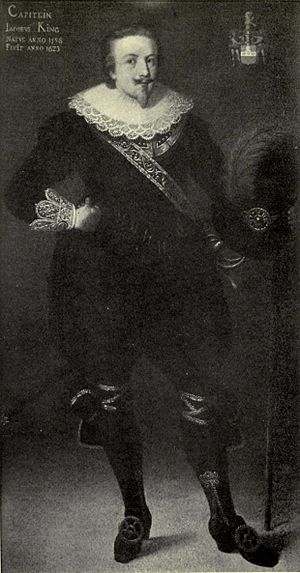James King, 1st Lord Eythin facts for kids
James King, 1st Lord Eythin, was a Scottish soldier born in 1589. He spent many years fighting in the Swedish army. Later, he returned to support King Charles I during the Bishops' Wars and the English Civil War. He was an important military leader during these times.
Contents
Early Life and Swedish Army Service
James King was born on Warbester Hoy, in the Orkney Islands of Scotland. He joined the Swedish Army in 1615. By 1622, he was a captain in a regiment led by Patrick Ruthven.
King quickly rose through the ranks. In 1634, he led three regiments during the siege of Hildesheim. For his success there, he was promoted to Major General.
Key Battles in Europe
By 1636, King became a Lieutenant General. He commanded the left side of the Swedish Army at the Battle of Wittstock. This was a major battle where he fought alongside Alexander Leslie.
After Wittstock, King's cavalry formed a special mobile army. They had a successful campaign around Minden in 1637. However, the Swedish army faced problems with their allies.
King was part of the allied forces defeated at the Battle of Vlotho. William Lord Craven and Prince Rupert of the Rhine were captured. King blamed Rupert's quick decisions for the loss. Rupert, in turn, blamed King for being too careful.
Leaving Swedish Service
After the Battle of Vlotho, King was given less important duties in Stockholm. He was also given a noble title. The Swedish leader, Axel Oxenstierna, felt King was too loyal to Charles Louis. Because of this, King was retired from the Swedish army in 1639.
Supporting King Charles I
After leaving Sweden, James King traveled to Hamburg. There, King Charles I hired him to recruit soldiers. King did not fight in the Bishops' Wars. These were conflicts between King Charles I and the Scottish Covenanters. This meant he avoided fighting against his old friend, Alexander Leslie.
When the English Civil War began in 1642, King was made Lord Eythin. He went to Europe to find experienced soldiers and weapons. He returned to England with Queen Henrietta Maria. He was then appointed Lieutenant General to the Marquess of Newcastle.
Battle of Marston Moor
On July 2, 1644, Prince Rupert arrived to help the Royalist army at York. Newcastle's army had been surrounded there. Rupert called Newcastle's troops to join him at Marston Moor. He was preparing for a big battle against the Covenanter and Parliamentarian armies.
The meeting between Rupert and King before the battle was tense. In the Battle of Marston Moor, the Royalist army was badly defeated. After this loss, Newcastle and his senior officers, including King, went into exile in Hamburg. They were very unhappy with Rupert's leadership.
Final Years
In March 1650, King was supposed to join an expedition led by James Graham, 1st Marquess of Montrose. This expedition landed in the Orkney Islands. However, King decided not to go. This was because Charles II made an agreement with the Covenanters. This agreement meant Charles II no longer supported Montrose. Montrose was later captured and executed.
James King died in Stockholm on June 9, 1652. He was honored by the Swedish court. He was buried in the Riddarholm Church, which is where Swedish kings are buried.
Family Life
James King was married twice. His first wife was Dilliana Van der Borchens. She was from Pomerania and died around 1634. They did not have any children.
With his second wife, whose name is not known, King had a daughter. Sadly, his daughter died before him. King's wills show that he left his belongings to his nephews, James and David King.


